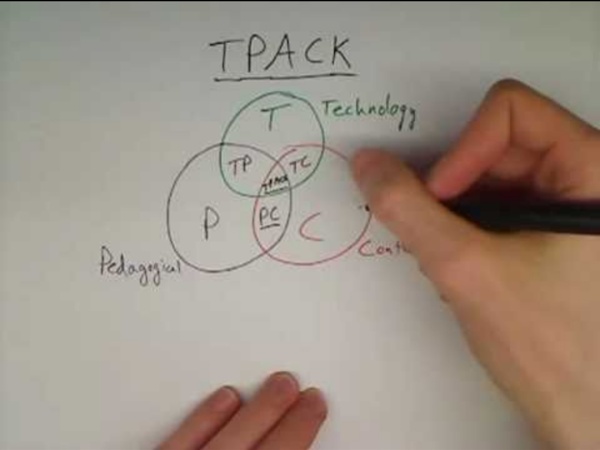



http://www.youtube.com/watch?v=0wGpSaTzW58
Related: Computer/Technology • EDUC_540 • Essentials in Learning and Technology • EDUC540Educational Technology TPACK, shown below, is a useful model for educators as they begin to use digital tools and strategies to support teaching and learning. This model, developed by educational researchers Mishra and Kohler (2006), is designed around the idea that content (what you teach) and pedagogy (how you teach) must be the basis for any technology that you plan to use in your classroom to enhance learning. Diagram and explanation ©2012 by tpack.org. Reproduced by permission of the publisher. Digital Technologies Hub Whether you are an experienced maths or computer science teacher or not, we all need to look at our own practice critically to ensure that we have the technological (T), pedagogical (P) and content knowledge (CK) necessary to design great learning for our learners’ needs. The TPCK model is a simple way to think about this. As teachers, it is important to be able to reflect on our own practice as learners. The greatest gift we can give the learners in our classes is the understanding that learning is a continual process and to model what it means to be a great learner. Throughout the Hub, you will find examples of pedagogical practice, Digital Curriculum content knowledge and references to the use of technology. Once you have completed this self-assessment, you can approach improving your TPaCK level by exploring some of the exemplars to see technology, pedagogy and content knowledge in situ.
8 Technologies That Will Shape Future Classrooms What does the future of learning hold? What will classrooms of the future be like? Emerging technologies such as cloud computing, augmented reality (AR) and 3D printing are paving the way for the future of education in ways we may have yet to see. At the very least though, we can extrapolate from what these promising technologies and predict how schools will adopt them in time to come. However, just as the original intentions for new technology often give way to innovative and unpredictable usage, we can never be sure if a twist is waiting for these rising stars. Tech & Learning An incredible tool to think about the integration of technology with instruction was developed in 2010 by Ruben Puentedera when he introduced what we now know as the SAMR model. The acronym stands for Substitution, Augmentation, Modification, and Redefinition, and the intention was to create a shared language across multiple disciplines so that teachers would be able to determine the best use of technology as an instructional tool. Loui Lord Nelson and Andrew Churches inspired Kathy Schrock to create the image above of the model associating it with the levels of the new Bloom’s Digital Taxonomy. Many teachers successfully adopted the SAMR model to help them determine the best way to introduce a technology and scaffold learning to the redefinition level.
The 8 Best Free Word Cloud Creation Tools For Teachers Editor's note: We have originally written and published this article in November 2013. Thanks to your useful suggestions and our own following of the latest developments in the fast paced field of technology, we have updated this piece in November 2015 in the hope that you will keep finding it useful. Thank you for sharing! ABCYa! Word CloudsAbout ABCYa!
A Guide for Bringing the SAMR Model to iPads When used effectively, iPads can develop thinkers and problem solvers. They can be used to transform learning inside and outside of the classroom, and offer limitless opportunities. Many educators are effectively integrating technology in the classroom using iPads to achieve the 4C’s, or “super skills,” that digital learners need to compete in our global society. But in order to do that, the focus has to shift from apps to content: that’s when true redefinition takes place. When my district rolled out our iPad initiative in 2012, teachers thought they needed specific apps for every content area.
Why do we need technology integration in education? Technology in education mirrors the fast-paced world we live in. In modern classrooms, it’s rare to find students all working on the same exact activity. Instead, today’s schools are technology-rich learning spaces that promote diverse activity. They’re abuzz with collaboration, critical thinking, creativity, and communication, all thanks to technology. Ask an administrator about using technology in the workplace, and you might hear about edtech as a tool for going about the business of school. Avoiding Plagiarism Tutorial <hr><p><b>You must have javascript enabled to view this website. Please change your browser preferences to enable javascript, and reload this page.</b></p><hr>
The Best Search Engines of 2020 Most people prefer to rely on just one or two search engines that deliver three key features: Relevant results (results you are interested in)Uncluttered, easy-to-read interfaceHelpful options to broaden or tighten a search The possibilities we highlight should help you find the best search engine for your needs. These are mainly web page search engines, but others exist, too, for specific searches. There are search engines just for people, images, and, of course, jobs. How to Cite an Image in APA Style This article reflects the APA 7th edition guidelines. Click here for APA 6th edition guidelines. An APA image citation includes the creator’s name, the year, the image title and format (e.g. painting, photograph, map), and the location where you accessed or viewed the image. When you include an image or photo in your text, as well as citing the source, you must also present it as a figure and include any copyright/permissions information.
What is an Infused Classroom? What is an Infused Classroom? Join the conversation about this post in our Facebook Group – with a community of amazing educators. In an Infused Classroom, the teaching and learning outcomes are the most important aspect, and technology simply enhances an already purposeful learning environment.